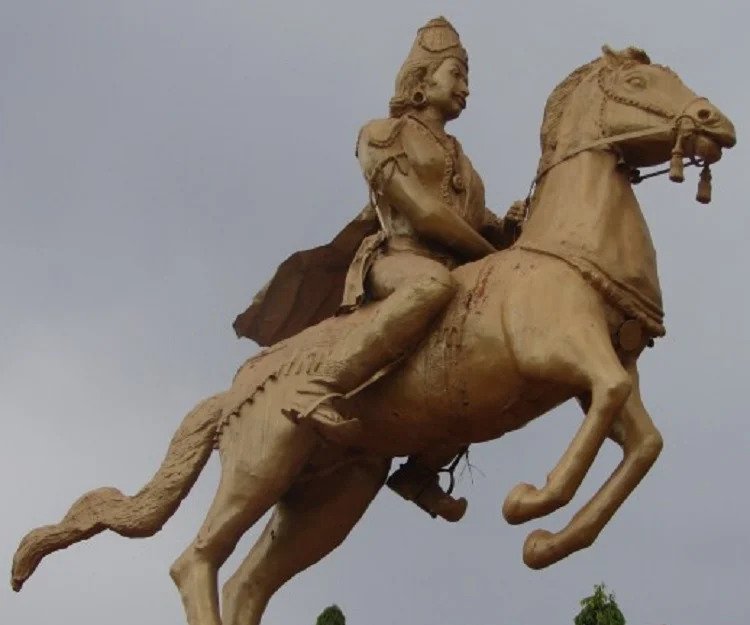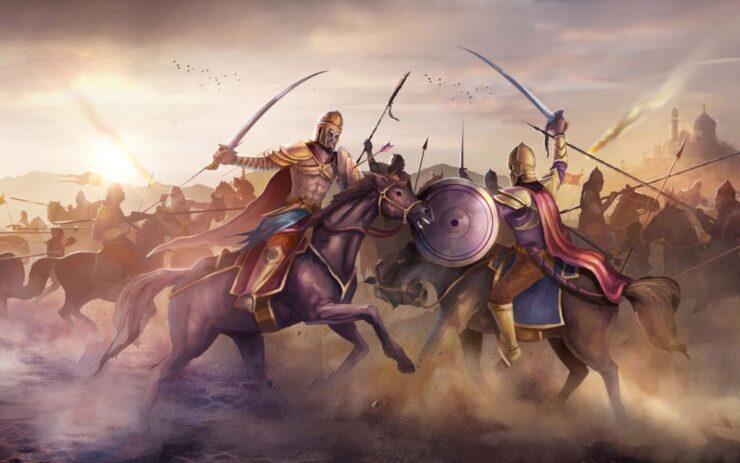Raja Raja Chola I was the greatest king of the Chola empire in southern India. The empire saw tremendous growth during his rule from 985 AD to 1014 AD. He conquered the kingdoms of southern India, his empire expanding as far as Sri Lanka in the south and Kalinga (Orissa) in the northeast.
Raja Raja fought many battles with the Chalukyas in the north and the Pandyas in the south. By conquering Vengi, Raja Raja laid the foundations for the Chalukya-Chola dynasty. He invaded Sri Lanka, which began a century-long Chola occupation of the island nation.
In order to streamline the administrative system, Raja Raja divided the empire into various districts and set standards for revenue collection through systematic land surveys. He built the magnificent Brihadisvara Temple in Thanjavur and through it enabled wealth distribution among his subjects. His successes enabled the splendid achievements of his son Rajendra Chola I under whom the empire attained the greatest extent and carried its conquest beyond the seas.
Early life
Raja Raja was the third child of Parantaka Sundara Chola and Vanavan Mahadevi and his birth name was Arulmozhivarman, popularly called Arulmozhi. He came to the throne at the death of Uttama Chola after a long apprenticeship as an heir apparent.
Raja Raja built the magnificent Brihadisvara Temple in Thanjavur and through it enabled wealth distribution among his subjects
During the lifetime of his father Sundara Chola, Arulmozhi had carved a name for himself by his exploits in the battles against the Sinhala and Pandyan armies. Sundara Chola’s eldest son and heir apparent Aditya II had been assassinated under unclear circumstances.
Uttama, as the only child of Gandaraditya, wanted the Chola throne as his birthright. After the death of Aditya II, Uttama forced Sundara Chola to declare himself heir apparent ahead of the popular Arulmozhi. Uttama made a compromise deal with Sundara Chola that Uttama will be succeeded not by his son but by Arulmozhi.
“Having noticed the marks (on his body) that Arulmozhi was the very Vishnu, the protector of the three worlds, descended on earth, [Uttama] installed him in the position of Yuvaraja (heir apparent) and himself bore the burden of ruling the earth …” says the Thiruvalangadu inscription.
Military campaigns
When Raja Raja came to the throne, he initially campaigned against the combined Pandya and Chera armies. However, there is no evidence of any military campaign undertaken by Raja Raja until the eighth year of his reign. During that period, he engaged in organising and augmenting his army and in preparing for military expeditions.
The campaign in the Kerala region in 994 AD marked the first military achievement of Raja Raja’s reign. His early inscriptions use the descriptive ‘Kandalur salai kalamarutta’ referring apparently to his destroying a fleet in the port of Kandalur, situated in the dominions of the Chera King Bhaskara Ravi Varman Thiruvadi (978–1036 AD).

According to inscriptions found in Thanjavur, there are frequent references to the conquest of the Chera king and the Pandyas in Malai Nadu (the west coast of South India). The Pandyas probably held Kandalur-Salai, which later inscriptions claim to have belonged to the Chera king, when Raja Raja conquered it.
In the war against the Pandyas, Raja Raja seized the Pandya king Amarabhujanga and the Chola general captured the port of Virinam. To commemorate those conquests, Raja Raja assumed the title Munmudi-Chola, (the Chola king who wears three crowns – the Chera, Chola and Pandya).
In a battle against the Cheras sometime before 1008 AD, Raja Raja stormed and captured Udagai in the western hill country. Kalingattuparani, a war poem written during the reign of Kulothunga Chola I, hints at a slight on the Chola ambassador to the Chera court as the reason for that sacking of Udagai. Raja Raja’s son Rajendra served as the Chola general leading the army in that battle. The Tamil poem Vikkirama Cholan mentions the conquest of Malai Nadu and the killing of 18 princes in retaliation of the insult offered to an envoy.
Victory over Lanka
To eliminate the remaining actor in the triumvirate, Raja Raja invaded Sri Lanka in 993 AD. The copper-plate inscription says that Raja Raja’s powerful army crossed the ocean by ships and burnt up the kingdom of Lanka. Mahinda V had been the king of Sinhalas. In 991 AD, Mahinda’s army mutinied with help from mercenaries from Kerala. Mahinda had to seek refuge in the southern region of Rohana. Raja Raja utilized that opportunity and invaded the island.
The Chola army occupied the northern half of Lanka and named the dominion ‘Mummudi Chola Mandalam’. Anuradhapura, the 1400-year-old capital of Sinhala kings, perished. The destruction was so extensive that the inhabitants abandoned the city. Cholas made the city of Polonnaruwa their capital and renamed it Jananathamangalam. The choice of that city demonstrates the desire of Raja Raja to conquer the entire island. He also built a Shiva temple in Pollonaruwa.

The Ganga country
Before the 14th year of his reign, in 998–999 AD, Raja Raja conquered Gangapadi (Gangawadi) and Nurambapadi (Nolambawadi), which formed part of the present Karnataka state. The Cholas never lost their hold of the Ganga country from the efforts of Sundara Chola, facilitating that conquest. The invasion of the Ganga country proved a complete success and the entire Ganga country came under the Chola rule for the next century.
An inscription of Raja Raja dating 1003 AD asserts that he captured Rattapadi by force. Rajendra led the Chola army against the western Chalukyas. According to the Hottur inscriptions of Satyasraya, dated 1007–1008 AD, the Chola king with a force numbering 900,000 had ‘pillaged the whole country.
Raja Raja’s inscriptions indicate that the Chola army’s elephants wrought havoc on the banks of the river Tungabhadra. Raja Raja failed to capture the western Chalukya capital Manyakheta. Though overwhelmed by the strength and rapidity of the Chola advance, Satyasraya soon recovered and, by hard fighting, rolled back the invasion.
Victory over Satyasraya
Raja Raja evidently attached much importance to his victory over Satyasraya, as he reportedly presented gold flowers to the Rajarajesvara temple on his return from the expedition. At the end of that war, the southern banks of the Thungabadhra river became the frontier between those two empires.
Raja Raja, who aimed at capturing every province that had ever been held by Parantaka I and extend the empire still further, sent a northern expedition early in his reign. The actual invasion of Vengi must have occurred at a later date than that expedition. Perhaps the interference of Satyasraya in the Vengi kingdom provided the trigger.
– The writer is a senior journalist and media consultant. The views expressed are of the writer and do not necessarily reflect the views of Raksha Anirveda
– The writer is a senior journalist and media consultant. The views expressed are of the writer and do not necessarily reflect the views of Raksha Anirveda.






